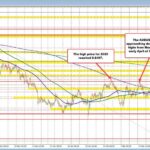
Trump vs. Harvard: A Battle Over Academic Freedom and Tax-Exempt Status
Tháng 4 15, 2025
AUD/USD Surges: Analyzing the Four-Day Rally and What Lies Ahead
Tháng 4 15, 2025Navigating the Turbulent Waters: Recent Developments in the Global Freight Market
The global freight market is currently experiencing a period of complex challenges and evolving dynamics, particularly affecting ocean carriers. As we approach a crucial period in 2025, there are several critical updates that industry stakeholders should be aware of. This blog post explores the strong initial performance, the fluctuating rates, geopolitical influences, and the ongoing uncertainties shaping the ocean freight landscape.
Strong First Quarter Amidst Looming Challenges
Ocean carriers are anticipated to report a robust first quarter in 2025. The driving force behind this anticipated success is attributed to elevated freight rates, particularly on key trade routes such as trans-Pacific and Asia-Europe. This strong performance provides a sense of optimism; however, concerns linger about the broader market conditions for the remainder of the year. Factors such as imposing US tariffs, a noticeable slowdown in demand, and an increase in capacity point to a challenging environment ahead. The balance of supply and demand is crucial, and with an oversupplied container shipping market, ocean carriers must tread carefully. Recent discussions, such as those involving China’s President Xi Jinping and top global CEOs, highlight the need for collaboration amidst these trade tensions. For more on this, you can read about three strategic moves by China and Xi.
Oscillating Ocean Freight Rates
In recent months, ocean freight rates have shown signs of declining momentum, especially in critical trade corridors such as China-North Europe and China-Mediterranean. It is evident that the initial uptick in rates, which generated enthusiasm across the industry, has given way to the realities of weakening demand. As consumer purchasing behaviors shift and economic conditions fluctuate, these changes inevitably affect freight rates, creating a ripple effect across the supply chain. It’s a time when investors should remain disciplined and patient, much like the principles of value investing that emphasize consistent strategy amidst fluctuating conditions. This can be explored further through the lens of 3 reasons Greenblatt says value investing beats the market.
Geopolitical and Economic Influences
The landscape of the ocean freight market is significantly influenced by geopolitical tensions and evolving global economic conditions. As manufacturers seek alternative production hubs and consumer demand shifts, carriers must adapt to these changes to remain competitive. These factors not only affect shipping tariffs but can also modify the route choices and funding strategies of shipping firms. The interconnections between international relations and logistics necessitate that ocean carriers stay informed and agile in responding to new developments.
Market Uncertainty and Contracting Season Challenges
The ocean freight contracting season is currently underway, marked by significant uncertainty in the marketplace. While many carriers are striving to maintain rate increases secured from the previous year, the recent plunge in ocean bookings adds an additional layer of volatility. This market uncertainty can lead to unpredictable freight rates, heightening the stakes for both carriers and their customers. The need for clarity and stability amidst fluctuating market conditions cannot be overstated. Carriers should also be mindful of common pitfalls in the investment landscape; avoiding key investment mistakes can be crucial for long-term success, as discussed in top investment mistakes to avoid in 2023.
Technological Innovations as a Lifebuoy
In a bid to regain balance in the freight market, technological advancements are proving vital. The ongoing digitalization of the shipping industry promises to enhance operational efficiency, potentially stabilizing freight rates. Through innovations in capacity management and predictive analytics, carriers can better navigate demanding market conditions. This technological shift not only prepares carriers for immediate challenges but also lays the groundwork for future resilience in a rapidly changing industry.
In conclusion, the global freight market, with its intricate web of challenges and uncertainties, requires ocean carriers to strategize thoughtfully as they embark on a complex journey ahead. As they prepare for the upcoming year, maintaining agility, embracing technology, and understanding the broader economic landscape will be paramount to their success. The journey through these tumultuous waters is far from straightforward, yet the ongoing evolution of the market provides an opportunity for growth and adaptability.
